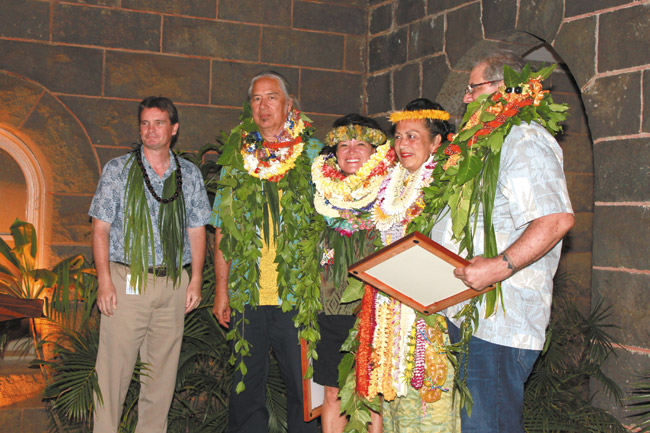Perpetuating Native Hawaiian Arts

Bishop Museum president and CEO Blair Collis honors MAMo awardees Duncan Ka’ohuoka’ala Seto, Meleanna Aluli Meyer, Paulette Kahalepuna and Kauka de Silva | Photo courtesy Bishop Museum
What do you get when you combine a painter/muralist, a ceramic artist, a lauhala weaver and feather lei maker? The answer is a jaw-dropping exhibit featuring delicate to commanding pieces created by four art extraordinaires who are deeply rooted in their Native Hawaiian culture.
Where might one get a rare peek at such an exquisite collection? None other than Bishop Museum’s J. M. Long Gallery. It’s all part of the museum’s and PA’I Foundation’s ninth annual Maoli Arts Month (MAMo), featuring an exhibition titled “He Kumu Kukui: Celebrating Our Masters.” Now through July 21, the spotlight shines on the artistic and educational contributions of four MAMo awardees.
The creations of Meleanna Aluli Meyer, Duncan Ka’ohuoka’ala Seto, Kauka de Silva and Paulette Kahalepuna are on display to celebrate the depth, breadth and diversity of the Islands’ visual arts community.
Meyer says, “The exhibition showcases the importance of culture and the arts because our wellness is tied to those things … and the children need to experience and embrace the arts in their schools, their activities and their lives.”
Meyer’s paintings come alive in her vibrant collections. She is known for her larger-than-life community-based mural projects at Hawaii Convention Center, Bishop Museum’s Pacific Hall, Camp Mokuleia, etc. Meyer is a Stanford graduate, professional arts educator, painter, theater designer, photographer and filmmaker.
“It takes a lifetime commitment to honor the essence of who we are,” she explains. “We are talking about energy and source. It is that source that gives us the capacity to solve big problems that we face today.”
It’s hard to miss her massive acrylic on canvas, “Na Kaula Akua” (cords that link to past generations), which was manifested in a waking dream. It portrays three large hands the size of a tabletop holding a round cord that drops from the heavens. It is as if a beam of light from a higher source has inspired this mastery that depicts three generations: kupuna, makua and keiki. Meyer is chanting with paint, paying tribute to her ancestors, the elderly, and connecting to the younger generation. The hands reach out to make a clear statement about the importance of family relations and genealogy.
Duncan Ka’ohuoka’ala Seto’s pieces are both traditional and contemporary. His creativity is channeled through his drawings, paintings and lauhala weaving. He was an apprentice to artist Betsy Astronomo under the state’s Folk Arts Program. He also learned his craft from other master weavers, including Gladys Grace, Jane Nunies and Elizabeth Lee.
“The weaving line has never been broken, as families passed this tradition down from one generation to another. All I am doing is perpetuating this art form within my ohana, through my local community, and as I interact with indigenous artists throughout the Pacific,” says Seto, who has mastered the twist and turns of complex weaving. Draped from the museum’s sky-high ceiling is a 3-by-30-foot mat that he and his family entwined for his son Poki’i’s wedding ceremony in 2012. Seto also weaves the message of love into his 3-D mat panels that include hearts being blown away by raging winds.
“Those woven hearts represent how individuals can weather the storms no matter how rough life can get,” says Seto. He considers himself blessed to have been surrounded by so many gifted kupuna in his lifetime, and that he was able to absorb their ano (essence), knowledge and talents.
The other two masters who feature their lifestyle creations are Kapiolani Community College arts professor Kauka de Silva and feather lei expert Paulette Kahalepuna. Incorporating umeki (calabash) through his ceramic work, de Silva expresses his ancestry and the Hawaiian environment through his motifs and colors. The public can see his wooden koa carvings sitting alongside his blue pottery at the museum.
Also on display is Kahalepuna’s feathered art. At the top of her field, and from a bird’s-eye view you can see that she has taken feather lei making to new heights. Her talents flow through her DNA as the daughter of “Feather Lady” Mary Lou Kekuewa. A must-see is her art depiction of a pikake four-strand lei. She is best known for the restoration and creation of numerous kahilu ku (tall feather standards) for Kamehameha Schools, Queen Liliuokalani Children’s Center and many others.
As Meyer, Seto, de Silva and Kahalepuna continue to grow a movement to keep their culture alive, these distinguished individuals stand firm in their convictions that perpetuating art in all forms boils down to understanding what the late Fijian Prime Minister and President Ratu Sir Kamisese Mara coined “The Pacific Way.”
May their inspiration continue to flow from within them as they connect with their roots, to their aina, the sea and the sky.
mufi@mufihannemann.com





